Parakrama Ekanayake
Spectrotemporal Feature Extraction in EHG Signals and Tocograms for Enhanced Preterm Birth Prediction
Sep 09, 2025Abstract:Preterm birth (PTB), defined as delivery before 37 weeks of gestation, is a leading cause of neonatal mortality and long term health complications. Early detection is essential for enabling timely medical interventions. Electrohysterography (EHG) and tocography (TOCO) are promising non invasive tools for PTB prediction, but prior studies often suffer from class imbalance, improper oversampling, and reliance on features with limited physiological relevance. This work presents a machine learning pipeline incorporating robust preprocessing, physiologically grounded feature extraction, and rigorous evaluation. Features were extracted from EHG (and TOCO) signals using Mel frequency cepstral coefficients, statistical descriptors of wavelet coefficients, and peaks of the normalized power spectrum. Signal quality was enhanced via Karhunen Lo\`eve Transform (KLT) denoising through eigenvalue based subspace decomposition. Multiple classifiers, including Logistic Regression, Support Vector Machines, Random Forest, Gradient Boosting, Multilayer Perceptron, and CatBoost, were evaluated on the TPEHGT dataset. The CatBoost classifier with KLT denoising achieved the highest performance on fixed interval segments of the TPEHGT dataset, reaching 97.28% accuracy and an AUC of 0.9988. Ablation studies confirmed the critical role of both KLT denoising and physiologically informed features. Comparative analysis showed that including TOCO signals did not substantially improve prediction over EHG alone, highlighting the sufficiency of EHG for PTB detection. These results demonstrate that combining denoising with domain relevant features can yield highly accurate, robust, and clinically interpretable models, supporting the development of cost effective and accessible PTB prediction tools, particularly in low resource healthcare settings.
Mamba-FCS: Joint Spatio- Frequency Feature Fusion, Change-Guided Attention, and SeK Loss for Enhanced Semantic Change Detection in Remote Sensing
Aug 11, 2025Abstract:Semantic Change Detection (SCD) from remote sensing imagery requires models balancing extensive spatial context, computational efficiency, and sensitivity to class-imbalanced land-cover transitions. While Convolutional Neural Networks excel at local feature extraction but lack global context, Transformers provide global modeling at high computational costs. Recent Mamba architectures based on state-space models offer compelling solutions through linear complexity and efficient long-range modeling. In this study, we introduce Mamba-FCS, a SCD framework built upon Visual State Space Model backbone incorporating, a Joint Spatio-Frequency Fusion block incorporating log-amplitude frequency domain features to enhance edge clarity and suppress illumination artifacts, a Change-Guided Attention (CGA) module that explicitly links the naturally intertwined BCD and SCD tasks, and a Separated Kappa (SeK) loss tailored for class-imbalanced performance optimization. Extensive evaluation on SECOND and Landsat-SCD datasets shows that Mamba-FCS achieves state-of-the-art metrics, 88.62% Overall Accuracy, 65.78% F_scd, and 25.50% SeK on SECOND, 96.25% Overall Accuracy, 89.27% F_scd, and 60.26% SeK on Landsat-SCD. Ablation analyses confirm distinct contributions of each novel component, with qualitative assessments highlighting significant improvements in SCD. Our results underline the substantial potential of Mamba architectures, enhanced by proposed techniques, setting a new benchmark for effective and scalable semantic change detection in remote sensing applications. The complete source code, configuration files, and pre-trained models will be publicly available upon publication.
Preprocessing Algorithm Leveraging Geometric Modeling for Scale Correction in Hyperspectral Images for Improved Unmixing Performance
Aug 11, 2025



Abstract:Spectral variability significantly impacts the accuracy and convergence of hyperspectral unmixing algorithms. While many methods address complex spectral variability, large-scale variations in spectral signature scale caused by factors such as topography, illumination, and shadowing remain a major challenge. These variations often degrade unmixing performance and complicate model fitting. In this paper, we propose a novel preprocessing algorithm that corrects scale-induced spectral variability prior to unmixing. By isolating and compensating for these large-scale multiplicative effects, the algorithm provides a cleaner input, enabling unmixing methods to focus more effectively on modeling nonlinear spectral variability and abundance estimation. We present a rigorous mathematical framework to describe scale variability and extensive experimental validation of the proposed algorithm. Furthermore, the algorithm's impact is evaluated across a broad spectrum of state-of-the-art unmixing algorithms on two synthetic and two real hyperspectral datasets. The proposed preprocessing step consistently improves the performance of these algorithms, including those specifically designed to handle spectral variability, with error reductions close to 50% in many cases. This demonstrates that scale correction acts as a complementary step, facilitating more accurate unmixing by existing methods. The algorithm's generality and significant impact highlight its potential as a key component in practical hyperspectral unmixing pipelines. The implementation code will be made publicly available upon publication.
BandRC: Band Shifted Raised Cosine Activated Implicit Neural Representations
May 16, 2025Abstract:In recent years, implicit neural representations(INRs) have gained popularity in the computer vision community. This is mainly due to the strong performance of INRs in many computer vision tasks. These networks can extract a continuous signal representation given a discrete signal representation. In previous studies, it has been repeatedly shown that INR performance has a strong correlation with the activation functions used in its multilayer perceptrons. Although numerous activation functions have been proposed that are competitive with one another, they share some common set of challenges such as spectral bias(Lack of sensitivity to high-frequency content in signals), limited robustness to signal noise and difficulties in simultaneous capturing both local and global features. and furthermore, the requirement for manual parameter tuning. To address these issues, we introduce a novel activation function, Band Shifted Raised Cosine Activated Implicit Neural Networks \textbf{(BandRC)} tailored to enhance signal representation capacity further. We also incorporate deep prior knowledge extracted from the signal to adjust the activation functions through a task-specific model. Through a mathematical analysis and a series of experiments which include image reconstruction (with a +8.93 dB PSNR improvement over the nearest counterpart), denoising (with a +0.46 dB increase in PSNR), super-resolution (with a +1.03 dB improvement over the nearest State-Of-The-Art (SOTA) method for 6X super-resolution), inpainting, and 3D shape reconstruction we demonstrate the dominance of BandRC over existing state of the art activation functions.
Enhanced SCanNet with CBAM and Dice Loss for Semantic Change Detection
May 07, 2025Abstract:Semantic Change Detection (SCD) in remote sensing imagery requires accurately identifying land-cover changes across multi-temporal image pairs. Despite substantial advancements, including the introduction of transformer-based architectures, current SCD models continue to struggle with challenges such as noisy inputs, subtle class boundaries, and significant class imbalance. In this study, we propose enhancing the Semantic Change Network (SCanNet) by integrating the Convolutional Block Attention Module (CBAM) and employing Dice loss during training. CBAM sequentially applies channel attention to highlight feature maps with the most meaningful content, followed by spatial attention to pinpoint critical regions within these maps. This sequential approach ensures precise suppression of irrelevant features and spatial noise, resulting in more accurate and robust detection performance compared to attention mechanisms that apply both processes simultaneously or independently. Dice loss, designed explicitly for handling class imbalance, further boosts sensitivity to minority change classes. Quantitative experiments conducted on the SECOND dataset demonstrate consistent improvements. Qualitative analysis confirms these improvements, showing clearer segmentation boundaries and more accurate recovery of small-change regions. These findings highlight the effectiveness of attention mechanisms and Dice loss in improving feature representation and addressing class imbalance in semantic change detection tasks.
Performance Benchmarking of Psychomotor Skills Using Wearable Devices: An Application in Sport
Nov 25, 2024



Abstract:This study proposes a versatile framework for optimizing psychomotor learning through human motion analysis. Utilizing a wearable IMU sensor system, the motion trajectories of a given psychomotor task are acquired and then linked to points in a performance space using a predefined set of quality metrics specific to the psychomotor skill. This enables the identification of a benchmark cluster in the performance space, allowing correspondences to be established between the performance clusters and sets of trajectories in the motion space. As a result, common or specific deviations in the performance space can be identified, enabling remedial actions in the motion space to optimize performance. A thorough validation of the proposed framework is done in this paper using a Table Tennis forehand stroke as a case study. The resulting quantitative and visual representation of performance empowers individuals to optimize their skills and achieve peak performance.
Iso-Diffusion: Improving Diffusion Probabilistic Models Using the Isotropy of the Additive Gaussian Noise
Mar 25, 2024Abstract:Denoising Diffusion Probabilistic Models (DDPMs) have accomplished much in the realm of generative AI. Despite their high performance, there is room for improvement, especially in terms of sample fidelity by utilizing statistical properties that impose structural integrity, such as isotropy. Minimizing the mean squared error between the additive and predicted noise alone does not impose constraints on the predicted noise to be isotropic. Thus, we were motivated to utilize the isotropy of the additive noise as a constraint on the objective function to enhance the fidelity of DDPMs. Our approach is simple and can be applied to any DDPM variant. We validate our approach by presenting experiments conducted on four synthetic 2D datasets as well as on unconditional image generation. As demonstrated by the results, the incorporation of this constraint improves the fidelity metrics, Precision and Density for the 2D datasets as well as for the unconditional image generation.
GAUSS: Guided Encoder-Decoder Architecture for Hyperspectral Unmixing with Spatial Smoothness
Apr 16, 2022



Abstract:In recent hyperspectral unmixing (HU) literature, the application of deep learning (DL) has become more prominent, especially with the autoencoder (AE) architecture. We propose a split architecture and use a pseudo-ground truth for abundances to guide the `unmixing network' (UN) optimization. Preceding the UN, an `approximation network' (AN) is proposed, which will improve the association between the centre pixel and its neighbourhood. Hence, it will accentuate spatial correlation in the abundances as its output is the input to the UN and the reference for the `mixing network' (MN). In the Guided Encoder-Decoder Architecture for Hyperspectral Unmixing with Spatial Smoothness (GAUSS), we proposed using one-hot encoded abundances as the pseudo-ground truth to guide the UN; computed using the k-means algorithm to exclude the use of prior HU methods. Furthermore, we release the single-layer constraint on MN by introducing the UN generated abundances in contrast to the standard AE for HU. Secondly, we experimented with two modifications on the pre-trained network using the GAUSS method. In GAUSS$_\textit{blind}$, we have concatenated the UN and the MN to back-propagate the reconstruction error gradients to the encoder. Then, in the GAUSS$_\textit{prime}$, abundance results of a signal processing (SP) method with reliable abundance results were used as the pseudo-ground truth with the GAUSS architecture. According to quantitative and graphical results for four experimental datasets, the three architectures either transcended or equated the performance of existing HU algorithms from both DL and SP domains.
Holistic Interpretation of Public Scenes Using Computer Vision and Temporal Graphs to Identify Social Distancing Violations
Dec 13, 2021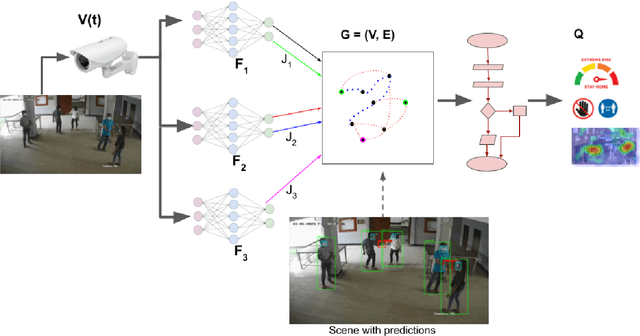

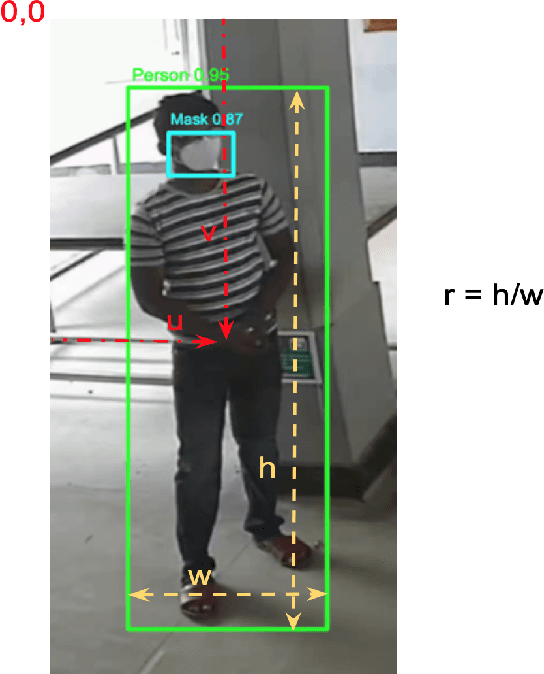

Abstract:The COVID-19 pandemic has caused an unprecedented global public health crisis. Given its inherent nature, social distancing measures are proposed as the primary strategies to curb the spread of this pandemic. Therefore, identifying situations where these protocols are violated, has implications for curtailing the spread of the disease and promoting a sustainable lifestyle. This paper proposes a novel computer vision-based system to analyze CCTV footage to provide a threat level assessment of COVID-19 spread. The system strives to holistically capture and interpret the information content of CCTV footage spanning multiple frames to recognize instances of various violations of social distancing protocols, across time and space, as well as identification of group behaviors. This functionality is achieved primarily by utilizing a temporal graph-based structure to represent the information of the CCTV footage and a strategy to holistically interpret the graph and quantify the threat level of the given scene. The individual components are tested and validated on a range of scenarios and the complete system is tested against human expert opinion. The results reflect the dependence of the threat level on people, their physical proximity, interactions, protective clothing, and group dynamics. The system performance has an accuracy of 76%, thus enabling a deployable threat monitoring system in cities, to permit normalcy and sustainability in the society.
Assessment of Fetal and Maternal Well-Being During Pregnancy Using Passive Wearable Inertial Sensor
Nov 19, 2021
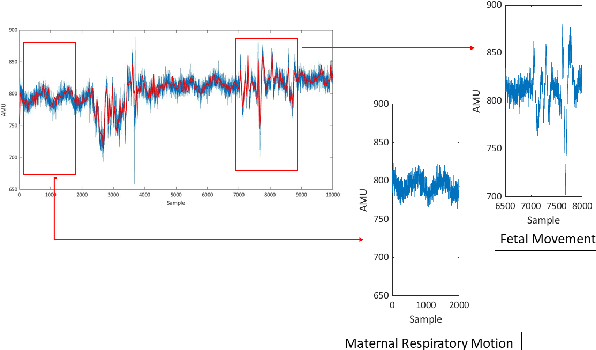
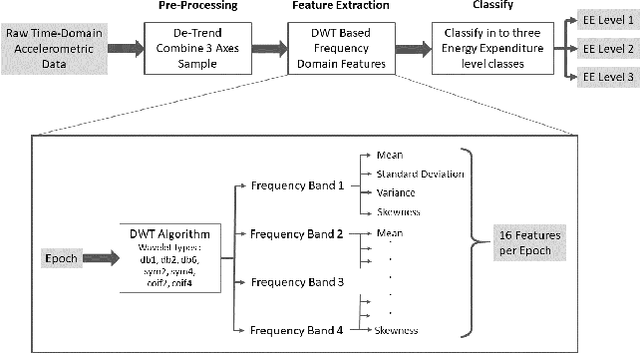
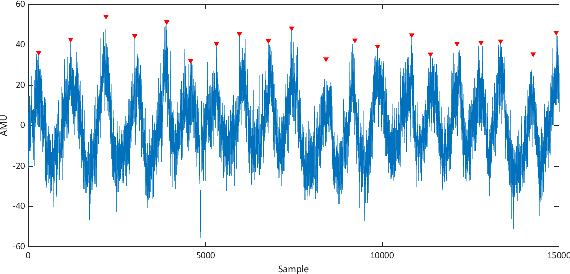
Abstract:Assessing the health of both the fetus and mother is vital in preventing and identifying possible complications in pregnancy. This paper focuses on a device that can be used effectively by the mother herself with minimal supervision and provide a reasonable estimation of fetal and maternal health while being safe, comfortable, and easy to use. The device proposed uses a belt with a single accelerometer over the mother's uterus to record the required information. The device is expected to monitor both the mother and the fetus constantly over a long period and provide medical professionals with useful information, which they would otherwise overlook due to the low frequency that health monitoring is carried out at the present. The paper shows that simultaneous measurement of respiratory information of the mother and fetal movement is in fact possible even in the presence of mild interferences, which needs to be accounted for if the device is expected to be worn for extended times.
 Add to Chrome
Add to Chrome Add to Firefox
Add to Firefox Add to Edge
Add to Edge